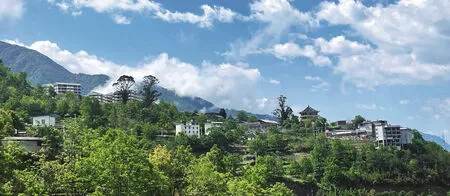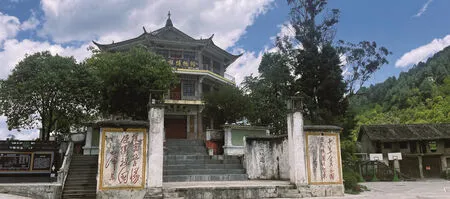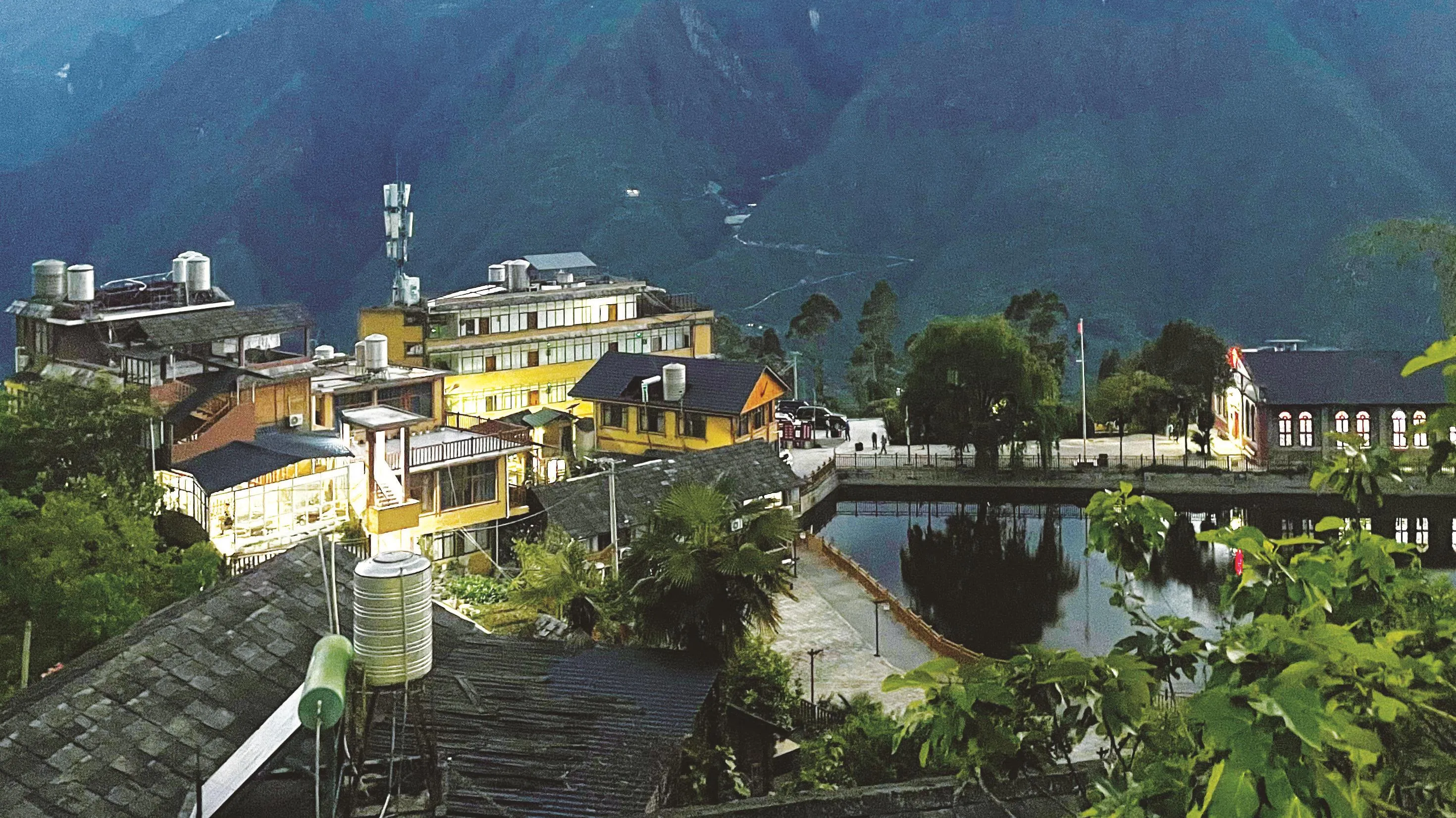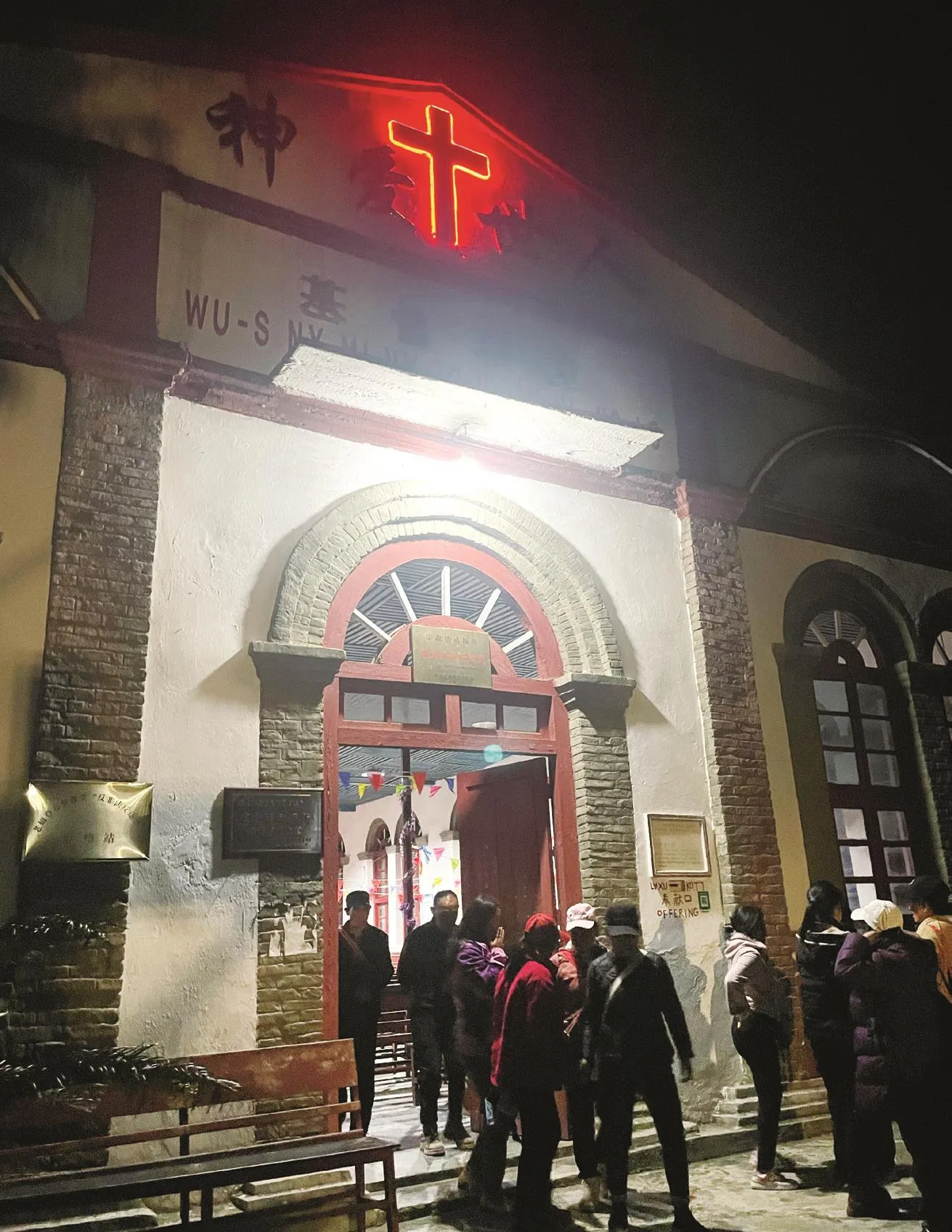Closer to Heaven
Text and photography by Hatty Liu
Yunnan’s remote Nujiang region is home to an oId Christian community, an abandoned government outpost, and a permanent tableau of hanging clouds
云南怒江游记:走进“人神共居”之处
The Salween River thunders below me, sending sprays of brown water against the giant boulders.As I look up and see waterfalls bursting out of cliff faces one after another,as if the mountains themselves can’t contain their might, I know I’m not the first or last person to find perfection in the Chinese name of East Asia’s last major undammed river,Nujiang (“Angry River”).
I’ve arrived at Laohutiao, or Tiger’s Leap, a gorge (not to be confused with the better-known tourist site on the Jinsha River) that marks the southern entrance to the Nujiang Grand Canyon.This is the real start of my journey,though I have already spent four bumpy hours on the road.These days, only one bus leaves per day for this remote northwestern corner of Yunnan province from the tourist hub of Dali,usually carrying a full suite of 20 passengers plus food supplies crammed into all the available aisle spaces, which it delivers to restaurants along its tortuous 10-hour, 500-kilometer route to Gongshan county.
The more impenetrable the region, the greater its attraction.
By the time I finally disembark at Pihe township, slightly over halfway through this route and another two hours upriver from Tiger’s Leap, I still have 30 minutes of a winding ride ahead of me on a motorized delivery tricycle next to several parcels bound for Laomudeng, a village 1,800 meters above the canyon where I was to stop for the night.
But if my road into Nujiang is arduous,there were plenty of people who had it harder.Sparsely settled by people of the Lisu and Nu ethnic groups, and ruled by Tibetan lamas via local warlords for many centuries, this region in China’s southwestern frontier received its first regular infusion of outsiders via the Catholic missionaries who trekked here not via Laohutiao, but the even more impenetrable northern route from Tibet.
Here, the Gaoligong and Biluo mountain ranges soar over 5,000 meters on either side of the canyon.As the water is too swift for boats, locals famously crossed the river via makeshift ziplines well into the 2010s; and until 2001, cars couldn’t penetrate into the region of Dulongjiang, a tributary of Nujiang on the upper reaches of the gorge, which instead relied on horse caravans for all its supplies.
But the more impenetrable the region, the greater its attraction: Just as today’s Nujiang Lisu Autonomous Prefecture is a pilgrimage for travelers seeking Shangri-la in one of China’s most well-trafficked provinces for tourists, the missionaries of old, first led by Father Charles Renou of the Paris Foreign Missions Society,made their intrepid way down the canyon after being driven out of Tibet in 1858.Perhaps here, they reasoned, far from the influence of Lhasa, they might have some luck converting Lisu and Nu peasants who already resented the monasteries that owned the local land.
They succeeded beyond their wildest expectations: In Fugong county, as of 2014,a Chinese Christian website estimated that 70,000 of the 90,000 local population were believers, and locals say each village has its own church—some 600 churches in the whole prefecture as of the start of this century.My destination is one of the biggest, the Laomudeng Christian Church, started in 1928 by Americans Leila and Allyn Cooke of the China Inland Mission, a Protestant organization proselytizing to the interior of China.Torn down 30 years later as part of the campaign against counter-revolutionaries in the 1950s, the current church was rebuilt in 1981 to seat 500 people, and continues to hold religious services five times a week.
My first glimpse of the fabled church is misted by a light drizzle—squeezed between two mountain ranges, and shadowed by the Tibetan Plateau, the Nujiang Canyon is also one of the rainiest places in Yunnan.Having spent almost a whole day in the 20-square-meter confines of a rumbling bus, I now while away the evening popping corn with a local family in their living room-turned-restaurant.We shave kernels from the cob into the open firepit, around which the Nu people (the main inhabitants of the village) traditionally cooked and ate in lieu of stoves or even tables, and eat them straight out of the ash when they burst.Outside the massive panoramic windows, framed by a riot of azaleas, the outlines of the Gaoligong Mountains gradually melt into the downpour and darkening sky until they are no more than inky blurs in the distance.
The winds intensify in the night.I can hear the storm echoing around the rocks and gullies in my sleep, and come morning, a cloud seems to have settled on the mountain.From my balcony on a hillside above the village, the view is nothing but white.
Gradually, though, a stillness settles in.The mist clears, leaving smokey tendrils spilling over the peaks and caressing the gorges.Below me, the valley is a tableau of cascading clouds,bamboo-thatched cottages, and a mirror-smooth pond reflecting the stately outlines of the old church.Of all the places in China that have claimed to be heaven on earth, I can most easily believe it here.
“Tourists like it.” Mr.Wu, my host, smiles when I exclaim over the view again at breakfast on his front porch, perched high enough on the hill that I feel I could fall off the edge.Like most inhabitants of earthly paradises, he claims to have long grown accustomed to the otherworldly scenery outside his home.Yet even he admits he isn’t used to the ways that the landscape seemingly changes by the minute.“Every time it rains, the sky turns a different color.”

The ruins of Zhiziluo, viewed from the trail from Laomudeng
An ardent believer, Mr.Wu has invited me along to the Saturday evening service at Laomudeng Church.First, though, I make my way to explore a different facet of local history.After a hike of 4.2 kilometers above Laomudeng, following the ever-moving clouds that seem to gather into a different shape each time I round a bend, I arrive in a village called Zhiziluo.It used to be better known as Bijiang,the capital of this county until 1974.
One of few cities in modernization-obsessed China to have lost its urban status, Bijiang saw its fate sealed when a team of experts from Beijing visited in the early ’70s and declared that its mountaintop location, though picturesque,was at high risk from landslides and other natural disasters—not somewhere the local authorities would want to house all its government bureaus,courts, post office, and military.
The offices and their staffers were migrated to Liuku, a town (now part of the city of Lushui)150 kilometers downstream beside the banks of Nujiang.The county of Bijiang ceased to exist entirely, subsumed by nearby Fugong.Now reverted to its Lisu name of Zhiziluo, the community became a time capsule overnight.Compared to the Nu-style dwellings in Laomudeng and surrounding villages, with walls made from woven bamboo (these days reinforced by concrete) meant to keep the interior warm in the winter, the concrete architecture of Zhiziluo is marked by a grandeur that is increasingly at odds with the jungly surroundings.I spy a small chicken straining to leap onto stately stone steps leading to what was a post office.
Bijiang may have been abandoned, but Zhiziluo is by no means deserted.A family now occupying the lower levels of the former post office tells me the government resettled them here from surrounding villages in the ’80s, and life in the community reverted to what it once was: planting tea in the nearby terraces, and cooking or keeping livestock in the former halls of administration.A neat row of underwear is hanging to dry in front of a wall carved with the “Quotations of Chairman Mao,” part of what used to be the Xinhua Bookstore.

The former “Worker’s Palace,” or recreation center, in Zhiziluo, will be converted into a museum on the Nu ethnic group.The Mao statue that figured prominently in Zhao Dayong’s film is no longer standing.
The abandonment of Zhiziluo provided the backdrop ofGhost Town, a three-hour documentary released in 2008 by Zhao Dayong, a director renowned for his lengthy,meditative forays into the lives of people left behind by China’s modernization.During the three parts of the film, the camera turns a seemingly unstructured gaze on the local pastor and his fundamentalist father’s debates over theology and family, down-on-their-luck locals like a young truck driver seeking his fortune and a young woman returned for a visit home after being trafficked to eastern China, and finally, a 12-year-old boy who appears to live alone after both of his parents left town.
Zhiziluo’s history is not explained in the film;there’s no indication that it is different from any other impoverished village on China’s frontiers, and viewers must take any quirks in the architecture for granted.The themes of abandonment and decay are mostly to be felt,rather than told: in the dreary repetition of its storylines; the roaming animals seemingly more alert and active than the humans;and the devout Christians, the last of those who’d known the missionaries and survived reeducation camps in the 1950s, spending time debating whether the Bible permits guitarplaying while a child in their neighborhood avoids starvation by hunting his own game.The slate-colored shell of the octagonal workers’recreation center, fronted by a starkly white statue of Chairman Mao (now no longer standing) in several transition shots, eerily suggests another kind of abandonment by more earthly authorities.
In the 15 years since the documentary, some buildings in Zhiziluo have received a lick of paint and plastering.Children no longer run wild in the streets, having moved away with their families for better education.Some of the eeriness remains, likely because of the wide boulevards built to accommodate much more traffic than needed by the 1,000 households that still live in the area today, according to estimates by a local woman surnamed Cheng.
Ms.Cheng, who operates a vegetable stand on the town’s main road, says her family no longer lives in the former government buildings but in the new apartment complexes which I later see on a hill above the town.As I view them after seeing the unfinished visitor center on the opposite end of town, the future of Zhiziluo suddenly falls into a pattern in my mind: The residents will be slowly moved out again, the government buildings refurbished, and the“town of memories” will hope to become a magnet for “red tourists,” nostalgic senior citizens, and other road-trippers exploring one of Yunnan’s last frontiers, as if the government workers had packed up and frozen it exactly in this state 40 years ago.What we will have lost are all the nuances in between.
Evening falls.The sky turns gold, purple,then a rich navy over the peaks.The bells of Laomudeng Church are tolling as I follow Mr.Wu down the steep hillside, pausing as he greets several children in the Nu language.
Turning away from a (ticketed) dancing performance in the town square, the handful of other tourists staying in the village seem also drawn to the open doors of the church where around 20 men, and far more women, are filing in, several bringing young children.Male and female, all are wearing woven bags that hang like a startling dash of color over their shoulder.
Seating is segregated by gender in the plain wooden pews, and Mr.Wu himself leads several rounds of acapella singing in the Lisu language—a third language after Nu and Mandarin for most villagers here.Without the need for notation, the congregation’s voices harmonize effortlessly and soar into the high octaves with a ringing echo.The sermon, too,is in Lisu, as are the Bibles everyone carries in their embroidered bag, printed in the Latin script standardized by missionary James O.Fraser in the 1920s.
Starting from 1978, the government gradually relaxed the ban on religious worship, and clergywas once again allowed to train in seminaries in Beijing and Kunming—including Laomudeng’s own Shan Lushi, who later tells me he used to preach in the county town of Fugong before retiring to lead the church in his home village.“I came back so I can grow vegetables when I’m not preaching,” he says with a laugh.

As the clouds change color over the village, the church lights up and opens its doors for the evening

Most of the worshipers are middleaged or elderly, except some very young children
In Leila Cooke’sFish Four and the Lisu New Testament, her memoir of a local man who helped translate scriptures into Lisu, she describes frequent struggles between missionaries who wanted to incorporate Lisu poetry and songs into the localized version of Christianity, and conservative local believers who destroyed their traditional instruments, “threw out their whisky and smashed their earthenware wine pots” once they heard the word of the Lord.In one village,she adds, “they threw out so much liquor that all the village pigs got drunk.”There’s still an austerity to the local version of the faith, with half-hour-long church services consisting of little more than preaching and a few hymns,squeezed in the afternoons and evenings after a long day in the fields.
The next morning, Mr.Wu shares proudly that faith has spared Nujiang from problems like alcoholism,gambling, and prostitution.Yet sitting on his porch,seemingly in touching distance of heaven, he becomes preoccupied with the subject of hell.His own grown-up children are not believers, nor able to read or speak Lisu, the language of religious services as well as government radio in Nujiang.In Zhiziluo, a handful of villagers I spoke to similarly warned me about “wickedness” that is drawing young people from their beliefs—new ideologies, as well as the distractions of technology, wealth, and other conveniences of modernity.
Mr.Wu isn’t against these conveniences—he points out to me, more cheerfully, that the more remote hamlets we see perched on the summits across the valley didn’t even have paved roads five years ago—but worries how the next generation will save its souls.“They will regret it,” he frets, “but it will be too late.” With this,he sets off for the church again, where the Sunday morning service had already begun.Afterward, I have time for one more handshake and a blessing from Pastor Shan, before it’s time to make the long descent back to earth.

